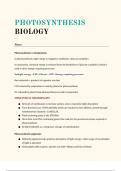Summary
photosynthesis summary
- Course
- Institution
coincise notes on photosynthesis, including the structure of chloroplasts, photosynthetic pigments, Thin layer chromatography, photsytems, light dependent and independent reactions, limiting factors.
[Show more]



